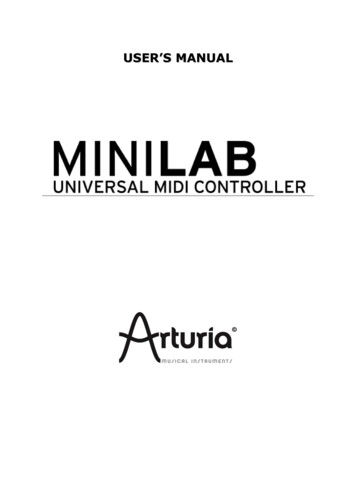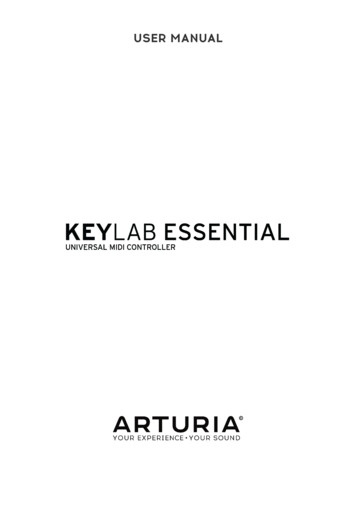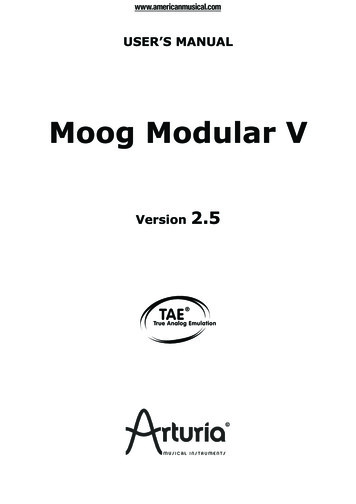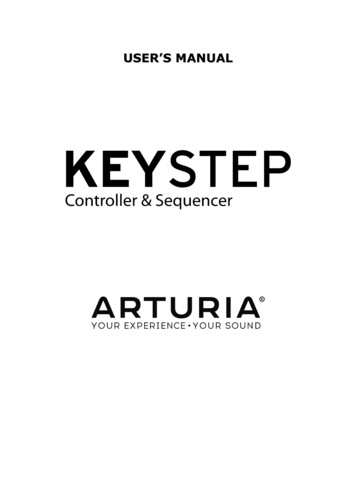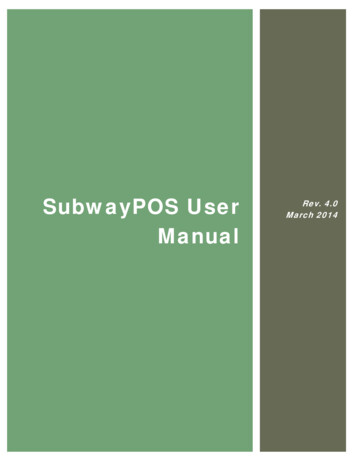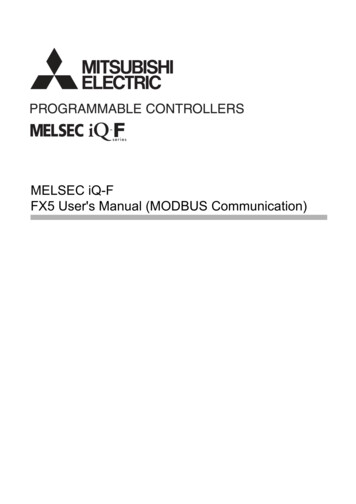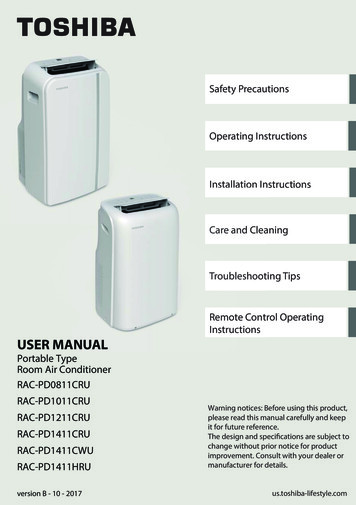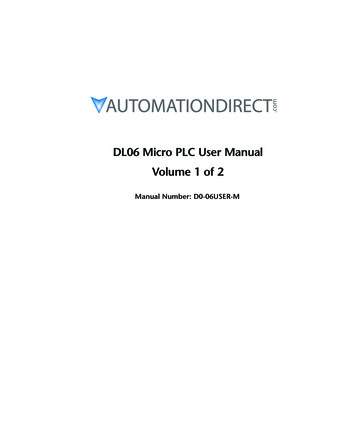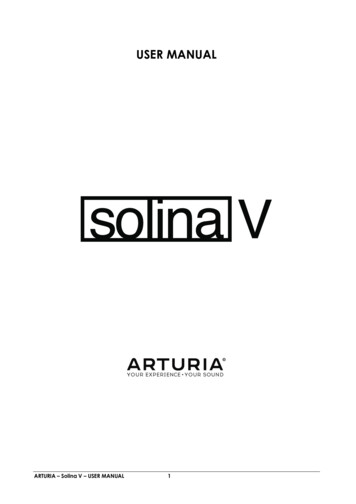
Transcription
USER MANUALARTURIA – Solina V – USER MANUAL1
DirectionFrédéric BrunKevin MolcardDevelopmentPierre-Lin Laneyrie (project manager)Theo Niessink (lead)Stefano D'AngeloBaptiste AubryCorentin Comte,Adrien CourdavaultBaptiste Le GoffValentin LepetitSamuel LimierGermain MarzinMathieu NocentiPierre PfisterBenjamin RenardDesignGlen DarceyShaun EllwoodMorgan PerrierSebastien RochardGreg VezonSound DesignGlen DarceyBoele GerkesRandy LeeTheo NiessinkErik NorlanderPierce WarneckeManualRandy LeeTomoya FukuchiJason ValaxSpecial ThanksChuck CapsisDenis EfendicBen Eggehorn,David FarmerRuary GalbraithJeff HalerKoshdukaiSimon McDonnellLewyn MitchellKen Flux PierceDaniel SabanChad WagnerARTURIA S.A. – 1999-2016 – All rights reserved.11 Chemin de la Dhuy38240 MeylanFRANCEhttp://www.arturia.comARTURIA – Solina V – USER MANUAL2
Table of Contents1INTRODUCTION . 51.1History of the original instrument . 51.1.11.1.1.1Chamberlin and Mellotron . 61.1.1.2Ken Freeman: string synthesist. 61.1.1.3Eminent . 61.1.21.22String theories . 5The ARP String Ensemble . 71.1.2.1Arrival of the fittest . 71.1.2.2Form factor. 81.1.2.3A string of spinoffs . 81.1.2.4String songs: a selected discography . 9Physical modeling synthesis. 101.2.1Music and math: yet another link . 101.2.2A computational conundrum . 101.2.3The endless revolution . 11ACTIVATION AND FIRST START . 122.1Register and Activate. 122.2Initial setup . 1232.2.1Audio and MIDI settings: Windows . 122.2.2Audio and MIDI settings: Mac OS X . 152.2.3Using Solina V in plug-in mode . 16USER INTERFACE . 173.1The virtual keyboard . 173.2Toolbar . 173.2.1Save Preset . 173.2.2Save Preset As . 183.2.3Import preset . 183.2.4Export preset . 193.2.5Resize window options . 193.2.6Audio settings . 203.2.7Preset browser overview . 203.2.8Open and Close Advanced section . 213.2.9MIDI Learn assignment . 213.2.9.1Assigning / unassigning controls . 223.2.9.2Min / Max value sliders . 233.2.9.3Relative control option. 233.2.9.4Reserved MIDI CC numbers . 233.2.10MIDI controller configuration. 243.2.11The lower toolbar. 243.2.11.1Current control value . 243.2.11.2MIDI Channel setting . 25ARTURIA – Solina V – USER MANUAL3
3.33.2.11.3MIDI preferences: the PREF button. 253.2.11.4Panic button and CPU meter . 283.2.11.5Poly . 28The Preset Browser . 293.3.1Searching presets . 293.3.2Using tags as a filter . 303.3.3The Preset Info section . 313.3.4Preset selection: other methods. 323.3.4.13.3.53.4Playlists . 333.3.5.1Add a playlist . 333.3.5.2Add a preset . 343.3.5.3Re-order the presets . 343.3.5.4Remove a preset . 343.3.5.5Delete a playlist . 34Main controls . 353.4.13.5Ensemble . 36Open mode. 373.5.1Overview. 373.5.1.14Selecting a preset by its Type . 33Coarse vs. Fine adjustments . 393.5.2Master section . 393.5.3LFO . 403.5.4Bass section: Filter, FENV and Sustain . 423.5.5Bass section: Arpeggiator. 433.5.6Upper Resonator. 443.5.7Effects . 453.5.7.1Amount controls . 473.5.7.2Effect sends . 473.5.7.3FX 1: Phaser . 483.5.7.4FX 1: Analog Chorus . 483.5.7.5FX 2: Analog Delay . 493.5.7.6FX 2: Digital Delay . 503.5.7.7Convolution Reverb. 50END USER LICENSE AGREEMENT . 53ARTURIA – Solina V – USER MANUAL4
1INTRODUCTIONArturia would like to thank you for purchasing our latest modeling synthesizer, SolinaV. We are confident it will become a valuable addition to your music productionstudio.If you’ve purchased our products before, you know we take great pride inrecreating the sound and feel of the original instruments. And then we top it offwith 21st century features the products might have had if the technology had beenavailable at the time!And if this is the first Arturia product you have owned, it is an excellent way tobecome acquainted with our stuff.The instrument upon which this virtual model is based played an important part inmany hit songs of the 1970s and early 1980s. And naturally it was a perfect fit forthe various forms of symphonic rock that flourished in those days, filling the spot thathad previously been held by the mercurial Mellotron.Since you obviously appreciate the Solina sound, we thought you might enjoy abrief look backward at what it took to bring this marvelous instrument to life.1.1History of the original instrument1.1.1String theoriesIn the early days of rock music there were very few options available to thekeyboard player in a band. The nicer clubs would have a grand piano or aHammond, the not-so-nice ones might have an upright piano (tuning optional),and the vast majority had nothing at all; if you wanted to play, you needed to bringsomething with you.Unfortunately, the options were limited to electric pianos and portable organs(some more portable than others). And while those instruments were certainlycapable of producing some great sounds, there was a hole they couldn’t fill: theirreplaceable lushness of a room full of violins, violas, cellos and contrabasses.There’s something about the sound of these instruments that can take a sweet lovesong and turn it into a heart-rending expression of the human condition.And it was impractical for studios to hire a small orchestra except for the mostimportant artists. The average musician could only dream that he might one dayhear his music with something more than basic instrumentation.So the stage was set for an instrument that would help fill these needs. Thankfully,certain technological innovations were just around the corner.ARTURIA – Solina V – USER MANUAL5
1.1.1.1 Chamberlin and MellotronOne of the first attempts to solve this problem was a keyboard which traces its rootsto the late 1940s, when a gentleman named Harry Chamberlin beganexperimenting with ways to trigger strips of magnetic recording tape from anorgan-style keyboard. His first device played back pre-recorded drum loops, andhe followed this with a series of keyboards that would play tapes of variousorchestral instruments. The age of samplers began with analog tapes!A bit of industrial drama led to an overlap between the Chamberlin products andtheir younger, more famous cousins, the Mellotrons. Suffice it to say that theseproducts were used extensively by major artists such as the Beatles, the MoodyBlues, King Crimson, Genesis, Led Zeppelin and Yes.However, their size, unreliability and price tag made them unsuitable for manypeople. The need for another solution was building.1.1.1.2 Ken Freeman: string synthesistAs a keyboard player in the mid-1960s, Ken Freeman saw first-hand the need for aninstrument to help him reproduce the string arrangements of popular music whenhis band played live shows. But a Mellotron was out of the question for most of thereasons already cited.He discovered through experiments with a Selmer Clavioline and a triple-headdelay unit that a single voice with vibrato could be made to sound like anensemble with the proper application of the delay unit’s three LFOs. This discoveryfueled his imagination and set in motion the development of the very first stringsynthesizer: the Freeman String Symphonizer.Unfortunately for Mr. Freeman, the alternate skittishness and sluggishness of thecompanies he courted for mass-production of his invention actually prevented theSymphonizer from being the first string synthesizer to make it to marketplace. But hedeserves our grateful thanks for his pioneering work in this area, which spurred thedevelopment of dozens of similar products.1.1.1.3 EminentIn 1972 a Dutch company by the name of Eminent Orgelbouw B.V. broadenedtheir product line with the introduction of the Eminent 310 series of console organs.Their targets at the time were the home and theater organ markets, which hadcertainly been kind to them.But perhaps unexpected was the impact the model 310 home organ would haveon the worldwide music scene within a few years. Their novel approach to the stringensemble issue caught the attention of an artist by the name of Jean Michel Jarre,who used the Eminent 310 strings for his seminal albums Oxygène and Équinoxe,released in 1976 and 1978, respectively.Prior to that Eminent must have recognized they had something special on theirhands, something that could stand on its own as a product and also fill a need thathad been simmering in an untapped marketplace for many years. And so in 1974,ARTURIA – Solina V – USER MANUAL6
two years after the initial introduction of the 310 series organs, the Eminent Solinawas born.The Solina had a 4-octave keyboard and only offered a handful of sounds. But theywere important sounds, ones that had been missing in the minds of many musicians:warm, ensemble strings that could fill out the sound while the guitarist took a solo;high string lines that could soar above the song and make it sparkle. And perhapsmost importantly, these sounds could be carried from gig to gig by one person,even though at nearly 50 pounds the Solina was quite heavy by today’s standards.But there was still one more step to be taken before the world would be introducedto perhaps one of the most sought-after vintage keyboards of all time: the ARPString Ensemble.1.1.2The ARP String EnsembleIt’s no mistake that the Eminent Solina and ARP String Ensemble sound alike: theyare the same keyboard with different labels. ARP had actually been in pursuit of anensemble synthesizer of their own design for some time, and for various reasonsdiscontinued their efforts and struck an agreement with Eminent to “rebadge” theirSolina as an ARP product.ARP was no “new kid on the block,” though, which is probably why the much largerEminent agreed to the deal; ARP had already established itself solidly within thesynthesizer marketplace with several impressive products, including the nowlegendary Odyssey. And so an unusual partnership was forged that proved to bea very wise move for both parties.Note: the first production version of the ARP String Ensemble was actually namedthe “ARP Model 2100 String Ensemble SE-IV”. But that’s a bit unwieldy, so this manualwill gradually transition from the name “ARP String Ensemble” to “Solina” to givecredit where credit is due.1.1.2.1 Arrival of the fittestAs mentioned previously, the ARP String Ensemble was not the first ensemblekeyboard to reach the ready hands of keyboard players around the world. But atsome point after its release in 1974 it became the standard-bearer for all thatfollowed.In fact, the String Ensemble has proven not only to be the most popular productARP ever made, but also the one with the most identifiable sound. The averageperson might hear a synth lead and not know whether it was an ARP, a Bob Moog'screation or an Oberheim, but the ARP String Ensemble has always benefited froma strong sound identity, easily recognizable. Some other synths were evensometimes mistaken for a String Ensemble so much it was a sound reference. Casein point: Jean Michel Jarre’s Oxygène and Équinoxe albums, which were releasedyears after the ARP String Ensemble hit the streets, used the Eminent 310, not anARP.ARTURIA – Solina V – USER MANUAL7
And even though its sound was obviously synthesized, as opposed to the “real”strings provided by the Mellotron tapes, it had certain advantages that made it thenatural selection for keyboard players around the world: smaller size and weight,no tapes to tune or break, and it didn’t cost as much as a house.ARP drove the point home in their marketing materials with statements like “Youcan hold a chord until you drop from exhaustion. That certainly beats the eightsecond limit found on other systems.” This was true: the Mellotron tapes were notloops; when a key was pressed they played for about 8 seconds before reachingthe end, and after that they needed to reset their position.To put things in perspective, that’s 2 bars of 4/4 time at 60 bpm. This forced thekeyboard player to be mindful when voicing chords, so as not to have a crucialnote drop out at a bad time. But the String Ensemble imposed no such limitation.1.1.2.2 Form factorAnother great thing the Solina had in its favor were its dimensions, especially thewidth (38”) and depth (14.5”). It stacked well on top of other “foundational”keyboards like the Rhodes, Wurlitzer and Hammond. It also had a sturdy, flat top,so it in turn could be used as a stackable surface for a smaller synth such as theOdyssey.So by the time the Solina was packed into its flight case, it took up less room in thetour bus cargo bay than almost anything else in the keyboard player’s rig. All thingstaken together, ARP and Eminent had produced a best-seller.1.1.2.3 A string of spinoffsIt is said that imitation is the most sincere form of flattery. In the business world,though, it is an attempt to eat the other guy’s lunch. The Solina and its siblings heldtheir own for quite a few years against a slew of competitors, and it is amazing theydid as well as they did. Take a look at just a small sample of what they were upagainst:YearARP modelCompetition1973Logan String Melody I1974Solina/SE-IVCrumar Stringman, EKO Stradivarius1975OmniRoland RS-101Godwin String Concert S249, Jen SM2007 String Machine, Roland RS-2021976Korg PE-2000Crumar Orchestrator, Hohner K4 / Stringer (USA) / String Performer (Europe)1977Omni 2Elgam String Ensemble, Logan String Melody II, Multivox MX202Oberheim Eight-voiceARTURIA – Solina V – USER MANUAL8
Farfisa Soundmaker, Roland RS-5051978QuadraOberheim OB-1Sequential Circuits Prophet 5Crumar Performer, Korg Lambda, Roland VP-330, Yamaha SK-10/20/30/50D1979Quartet*Siel Orchestra (*rebadged for ARP as the Quartet)Oberheim OB-XGodwin Model 749 String Concert, Korg Trident1980Oberheim OB-Xa1981Roland Jupiter 8Note the appearance of the first 8-voice programmable synthesizer in 1977,followed rapidly by others of varying polyphony but increasing popularity. By 1981the competition was too fierce, the research and development costs were toohigh, and the public interest in ensemble synthesizers had waned. Sadly, ARPInstruments, Inc. was forced to close its doors.But its legacy lives on in the 21 st century, as synthesizer enthusiasts are once againpaying top dollar for ARP synthesizers, including the Solina String Ensemble. And it iswith the utmost respect for the history of the technology and the music it inspiredthat we offer to you the Arturia Solina V.1.1.2.4 String songs: a selected discographyThe Solina string sound has been used to great effect on many albums through theyears. Here is a brief overview:Dream Weaver – Gary WrightI’m In You – Peter FramptonThe Grand Illusion – StyxCaptain Fantastic – Elton JohnCome Get It! – Rick JamesRumours – Fleetwood MacThrust – Herbie HancockThe Age of Plastic – The BugglesWish You Were Here – Pink FloydPremiers Symptômes – AirWe could go on and on; there are literally thousands of recordings where the Solinasound played a major role. And now with Solina V we hope to see many thousandsmore!ARTURIA – Solina V – USER MANUAL9
1.2Physical modeling synthesisWhen you want to create a sound, there are many methods of synthesis from whichto choose: Additive, which creates a timbre by adding various waveforms togetherSubtractive, in which partials of an audio signal are attenuated by a filter toreduce the original harmonic content of the soundFrequency Modulation (FM), where waveforms are used incarrier/modulator relationships and tuned according to the harmonic seriesto produce overtones in the carrier wavesWavetable, which offers a wide selection of digital waveforms and thenallows them to be layered, filtered, and/or used as the crossfade targets ofan X/Y controller or a looping envelopeSample Playback, where recordings of a sound are triggered by a playbackdevice, and can be transposed by increasing the playback speed whendifferent pitches are requiredGranular, which splits samples into very short “grains” and allows them to bemanipulated through a myriad of playback options, andPhysical modeling. In this method the output waveform is calculatedaccording to a set of equations and algorithms derived through extensiveanalysis of a physical sound source.1.2.1Music and math: yet another linkA physical model attempts to codify the laws of physics that govern a particularform of sound generation. A model typically will have multiple parameters, someof which are constants that describe the physical materials and dimensions of theinstrument, while others are time-dependent components representing theplayer s interaction with the instrument, such as plucking a string, pressing a valve,or reducing the pressure of his embouchure, etc.This idea has been around for a long time, but development has been hindereduntil recently because processors that were powerful enough to handle thecomputational complexity of the physical models either didn’t exist or were tooexpensive.But if you’ve been watching the technological trajectories, you know those daysare in the past. And we’re just as happy about that as you are.1.2.2A computational conundrumHere’s an example of what must be taken into account while developing aphysical model. To recreate the sound of a drum, for instance, a formula must bein place to represent all of the ways the collision between a drum stick and a drumhead sends shockwaves through a two-dimensional membrane. Among otherthings, the formula must incorporate:ARTURIA – Solina V – USER MANUAL10
The properties of the striker: its rigidity, the velocity of the hit, the material,and how/where the strike happensThe membrane: its mass density, elasticity, woven fabric vs. plastic vs. skin,etc.The sympathetic resonances of the membrane and the body of the drumThe conditions at the membrane boundaries: is there a rigid termination tothe drum s body, or are there multiple, independently adjustable pressurepoints?The ancillary and perhaps lingering response of additional components,such as the snares under a snare drum.Similar complexities can be found in instruments such as an acoustic guitar. A fewyears ago, a French scientist finally completed a comprehensive modeling of allacoustic guitar parameters. The calculations to produce the sound took threedays!The second-biggest challenge of physical modeling synthesis is to simplify thealgorithms wherever possible without sacrificing the essential nature of theinstrument being modeled. The goal is to achieve an efficient model which can beused interactively, in real time, without limiting the spontaneous paths a musicianmay take during a rush of creativity.1.2.3The endless revolutionThere are several methods of physical modeling synthesis, including Karplus-Strongalgorithms, digital waveguide synthesis, and formant synthesis. Each one uses adifferent paradigm to bring a modeled sound to its musical fruition.The salient point here is that physical modeling synthesis is capable of recreatingthe character of a “real” instrument during performance, including its subtlenuances of expression, while using a thousand times less hard drive space than the“sampling” method would take to produce an inferior result.Not to rub it in, but we really should mention the ability of physical modelingalgorithms to combine parameters into instruments that have never existed. Thereis no limit to the types of sounds physical modeling synthesis can produce!And when you gather a bunch of music fanatics who also possess a knowledge ofthe pertinent laws of physics and an in-depth understanding of the characteristicsof electronic circuits, you wind up with Arturia. And Arturia now offers you our latestbrainchild, the Solina V.May it light the fires of creativity for you!ARTURIA – Solina V – USER MANUAL11
2ACTIVATION AND FIRST START2.1Register and ActivateSolina V works on computers equipped with Windows 7 or later and Mac OS X10.8 or later. You can use the stand-alone version or use Solina V as an AudioUnits, AAX, VST2 or VST3 instrument.Once Solina V has been installed, the next step is to register the software.The registration process will require you to enter the serial number and theunlock code you received with the product.In order to proceed, go to this web page and follow the instructions:http://www.arturia.com/registerNote: If you don’t have an Arturia account yet, you will need to create one.The process is quick, but it does require that you can access your email addressduring the registration process.Once you have acquired an Arturia account you will be able to register theproduct.2.2Initial setup2.2.1Audio and MIDI settings: WindowsAt the top left of the Solina V application is a pull-down menu. It containsvarious s
ARTURIA – Solina V – USER MANUAL 6 1.1.1.1 Chamberlin and Mellotron One of the first attempts to solve this problem was a keyboard which traces its roots to the
